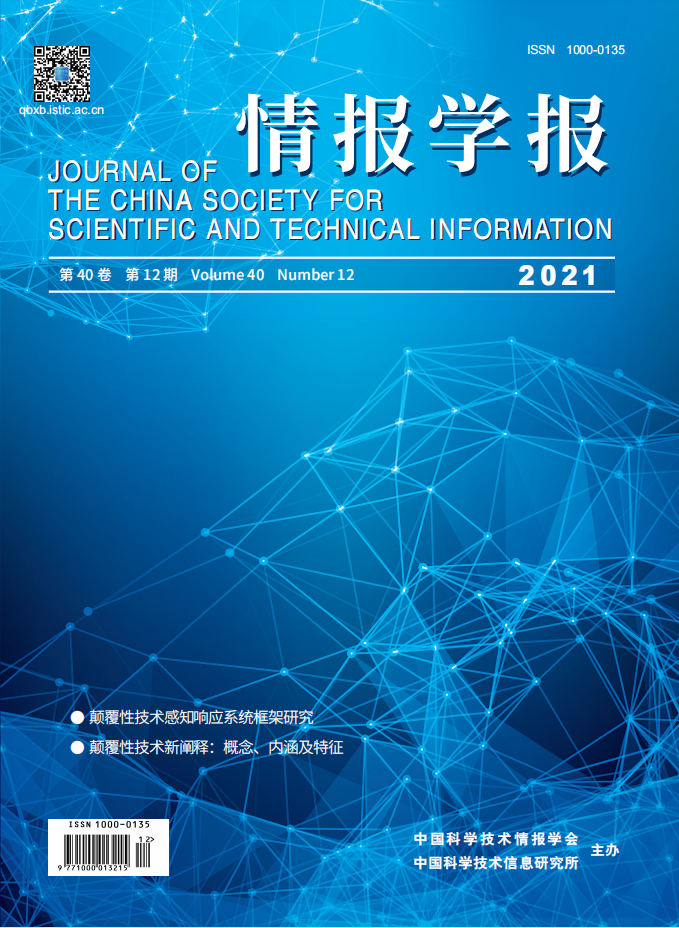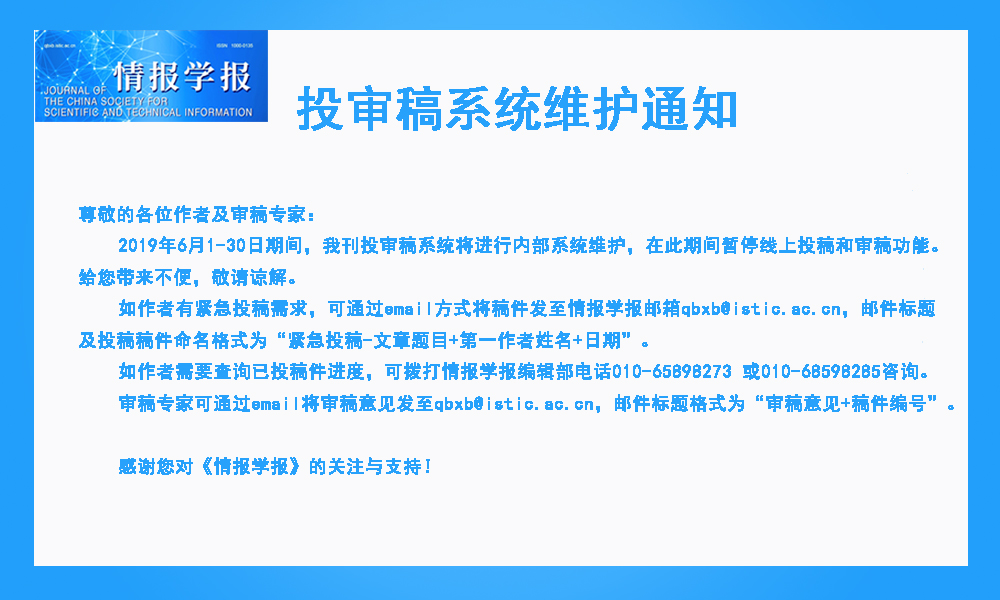 |
|
2022 Vol. 41, No. 8
Published: 2022-08-24 |
|
|
| |
|
|
|
|
|
775 |
Theoretical Framework of Altmetrics Hot! |
|
 |
Yu Houqiang |
|
|
DOI: 10.3772/j.issn.1000-0135.2022.08.001 |
|
|
Altmetrics is a typical data-driven research area. With the wide application of altmetrics services, there is increasing demand of in-depth development of altmetrics data, which strongly requires theoretical guidance and support. Therefore, this study summarizes and proposes a logically rigorous and structurally clear theoretical framework, aiming to boost the in-depth development of altmetrics. The theoretical framework consists of three-level theories, i.e. macro-level scientific paradigm revolution theory, meso-level scientific work computerization theory, and micro-level engagement degree spiral theory. The scientific paradigm revolution theory is based on the concept of Kuhn's scientific paradigm, expounds the primary principle of scientometrics extending to altmetrics, and is the foundation of altmetrics as an independent research area. The scientific work computerization theory reveals the underlying logic of the scientific communication process that diversifies altmetrics data, explains the primary cause of the difference presented in the level of engagement, and reasons the underlying relationship of different types of altmetrics data. This coherent theoretical framework is helpful in understanding and grasping the forming process, basic idea, and application principles of altmetrics holistically. Lastly, the study proposes the advancement of the future altmetrics theory by incorporating relevant theories and developing unique altmetrics theories. |
|
|
2022 Vol. 41 (8): 775-785
[Abstract]
(
457
)
HTML
(1 KB)
PDF
(1734 KB)
(
532
) |
|
|
|
796 |
Semantic- and Contextual-based Author Bibliographic Coupling Analysis Hot! |
|
 |
Zhang Ruhao, Yuan Junpeng |
|
|
DOI: 10.3772/j.issn.1000-0135.2022.08.003 |
|
|
Author bibliographic coupling analysis (ABCA) is an important tool for detecting active research communities and mapping domain knowledge structures. ABCA only uses the citation count to naively represent the bibliographic coupling relevance strength between authors, ignoring their similarities at a deep internal level. To enhance the reliability and insight of ABCA, this study attempts to use rich full-text resources to mine key information contained in the citation content, and proposes an innovative method, named semantic- and contextual-based author bibliographic coupling analysis (SC-ABCA), which aims at enhancing the strength of the similarity of citing motives from the essential level. By mining the full-text of scientific literature, the proposed method extracts the features of semantics and context of citations to calculate the enhanced bibliographic coupling strength and assign a different similarity value to each bibliographic couple. Through the “paper-topic-author” aggregation mapping, which considers each author's interests toward multiple current topics, this method shows the topic similarity relationship between authors. This research also performs an empirical study using 13,562 full-text papers in the field of Chinese LIS. The result shows that the proposed method performs better than ABCA on author community discovery and maps a more detailed knowledge structure. It has a higher content coherence gain and the probability of mutual citation inside clusters; additionally, the method is more robust when facing large-scale author data and has potential for further expansion and application. |
|
|
2022 Vol. 41 (8): 796-811
[Abstract]
(
549
)
HTML
(1 KB)
PDF
(5171 KB)
(
593
) |
|
|
|
822 |
Impact of Article Similarity on Citation Counts during Researchers' Career Development Hot! |
|
 |
Zhang Lihua, Zhang Kangning, Zhao Yingguang, Zhang Zhiqiang |
|
|
DOI: 10.3772/j.issn.1000-0135.2022.08.005 |
|
|
During each researcher's career development, it is fundamental that they pay attention to the serious issue of identifying an appropriate time to change their research direction, if needed. This study aims to explore the impact of article similarity on citation counts during researchers' career development. Based on the data of authors and papers of “Business & Economics” and “Computer Science, Artificial Intelligence,” a negative binomial regression model was constructed with article similarity as the independent variable; citation counts of article as the dependent variable; and the number of authors, length of papers, number of references, journal influence factors, and author's academic age as control variables. The results show that article similarity during a researcher's career development in the two disciplines presents the distribution characteristic of “high in the middle and low on both sides.” Notably, 39.5 percent of researchers in Business & Economics switched their research topics, and article similarity proved to have no effect on citation counts. However, 45.6 percent of researchers in Computer Science, Artificial Intelligence also changed their research topics, and article similarity impacted citation counts. |
|
|
2022 Vol. 41 (8): 822-831
[Abstract]
(
297
)
HTML
(1 KB)
PDF
(879 KB)
(
609
) |
|
|
|
845 |
Diffusion Features of Disruptive Technology from the Life Cycle Perspective Hot! |
|
 |
Wang Chao, Ma Ming, Wang Haiyan, Xia Dong, Xu Haiyun |
|
|
DOI: 10.3772/j.issn.1000-0135.2022.08.007 |
|
|
The identification of proliferation features of disruptive technologies is greatly significant in identifying potentially disruptive technologies. Based on the technology diffusion theory proposed by E. M. Rogers, we construct a research framework for the diffusion of disruptive technological innovation from the life cycle perspective, and conduct research on the features of disruptive technological diffusion using bibliometric and altmetrics indicators. First, through a large-scale survey, we obtain the disruptive technology list in which all technologies are unanimously recognized by the government, industry, and academia. Next, using bibliometric and altmetrics methods, we explore the diffusion features of disruptive technological innovation from the perspective of the technology life cycle. Finally, five key diffusion features of disruptive technology are obtained, including the cycle, diffusion rate, diffusion hysteresis, diffusion disorder, and diffusion dominance. This study provides new insights for exploring the features and patterns of disruptive technological innovation and support the selection of potential disruptive technologies. |
|
|
2022 Vol. 41 (8): 845-859
[Abstract]
(
455
)
HTML
(1 KB)
PDF
(4613 KB)
(
576
) |
|
|
|
860 |
Information Multi-hierarchical Classification of Online Q&A Community Oriented to Users' Needs Topics Hot! |
|
 |
Cheng Quan, Zhang Yangang |
|
|
DOI: 10.3772/j.issn.1000-0135.2022.08.008 |
|
|
The extensiveness, convenience, interactivity and individual characteristics of the online question and answer (Q&A) community service has promoted the rapid development of the proposed model. The online Q&A community has gradually become an important platform for people to obtain various types of life-related information. However, due to the lack of effective organization of the information resources in the community and the lack of semantic relevance and other practical bottlenecks, as well as the high complexity and multi-hierarchical characteristics of such information, users’ experience in this regard is not typically satisfactory. To achieve the fine-grained organization and the semantic relationship disclosure of various information resources in the online Q&A community and subsequently achieve the goal of accurate classification of information based on user needs, a multi-hierarchical architecture system of user needs is built using the user search data in the online mother-infant community. Further, verified experimental samples of the labeled data are generated with multi-hierarchical needs themes. Finally, the classification effect of the UNT-HC (users' needs topics - hierarchical classification) is verified by comparing the information multi-hierarchical classification model (UNT-HC) constructed by this research institute for user-oriented topics with the TextAttBiRNN (text attention bi-directional recurrent neural network) single-hierarchical classification model and multi-hierarchical classification models, such as HFT-CNN (hierarchical fine-tuning conventional neural network) and HCCNN (hierarchical classification conventional neural network). The proposed model showed superior performance in realizing the multi-hierarchical single-label and ultra-fine-grained text information classification applications in the online Q&A communities. |
|
|
2022 Vol. 41 (8): 860-871
[Abstract]
(
409
)
HTML
(1 KB)
PDF
(4391 KB)
(
377
) |
|
|
|
872 |
Multi-perspective Analysis of the Faculty Construction of Information Science in China Hot! |
|
 |
Wang Wei, Cao Siyuan, Liang Jiwen, Yang Jianlin |
|
|
DOI: 10.3772/j.issn.1000-0135.2022.08.009 |
|
|
Improvement in faculty construction is instrumental in promoting the long-term development of education in Information Science. It is of significant importance to analyze the current level of faculty construction based on open-source data, providing a reliable reference for improving the professionalism of teachers. This study surveyed 655 teachers, with a master’s degree program in information science, in 49 institutions. Data were collected from different sources, including teachers’ curriculum vitae, academic dissertations, journal papers, and national funds. We systematically analyzed teachers’ characteristics in target institutions from various perspectives, including the composition of organizations and faculty, teachers’ titles, educational backgrounds, the topic of funds, and the evolution of research interests. The research results show that in China, the faculty of information science has developed an initial scale and presented a regional aggregation. The knowledge structure of teachers has been significantly diverse. Teachers’ research topics have expanded in new directions. Specifically, the traditional research topics of information science exhibit both new developments and aging trends. Topics such as information behavior, open-source data, and digital humanities are being increasingly studied. Research on information science theories and methods is resurfacing. Based on a comprehensive analysis, it is suggested that interdisciplinary innovation should be encouraged, based on strengthening the core theory of information science. Various career development paths should be provided for teachers, which is the internal need of discipline construction. Other measures should be encouraged, including clarifying the general requirements of faculty development and improving teacher performance. |
|
|
2022 Vol. 41 (8): 872-883
[Abstract]
(
260
)
HTML
(1 KB)
PDF
(3263 KB)
(
477
) |
|
|
|


